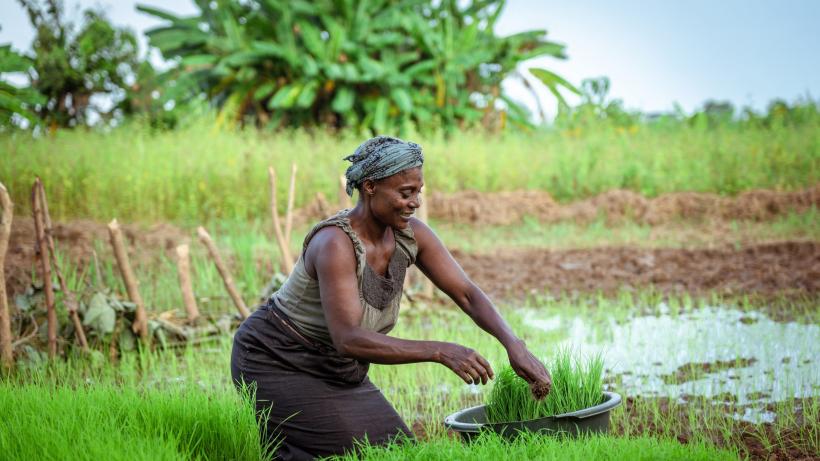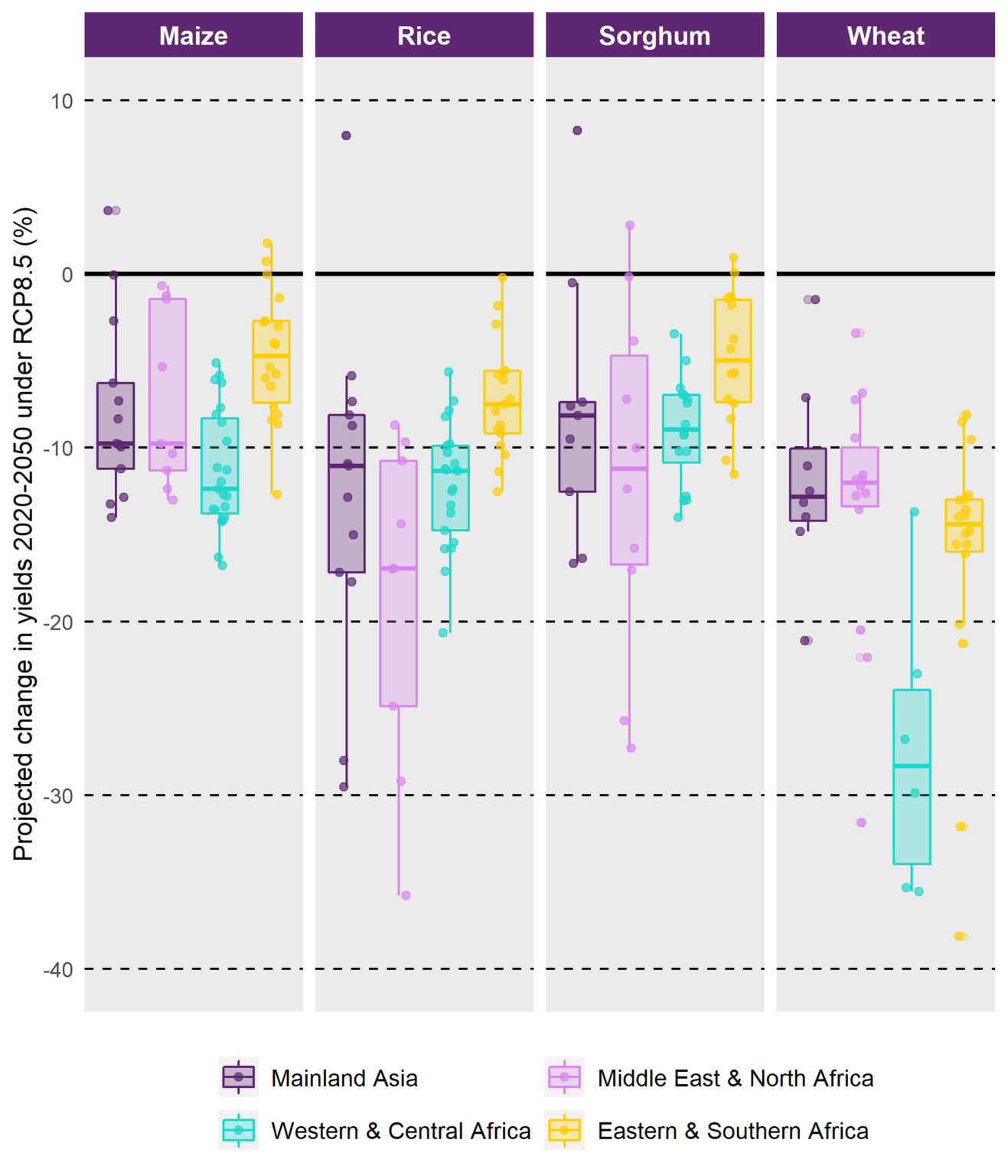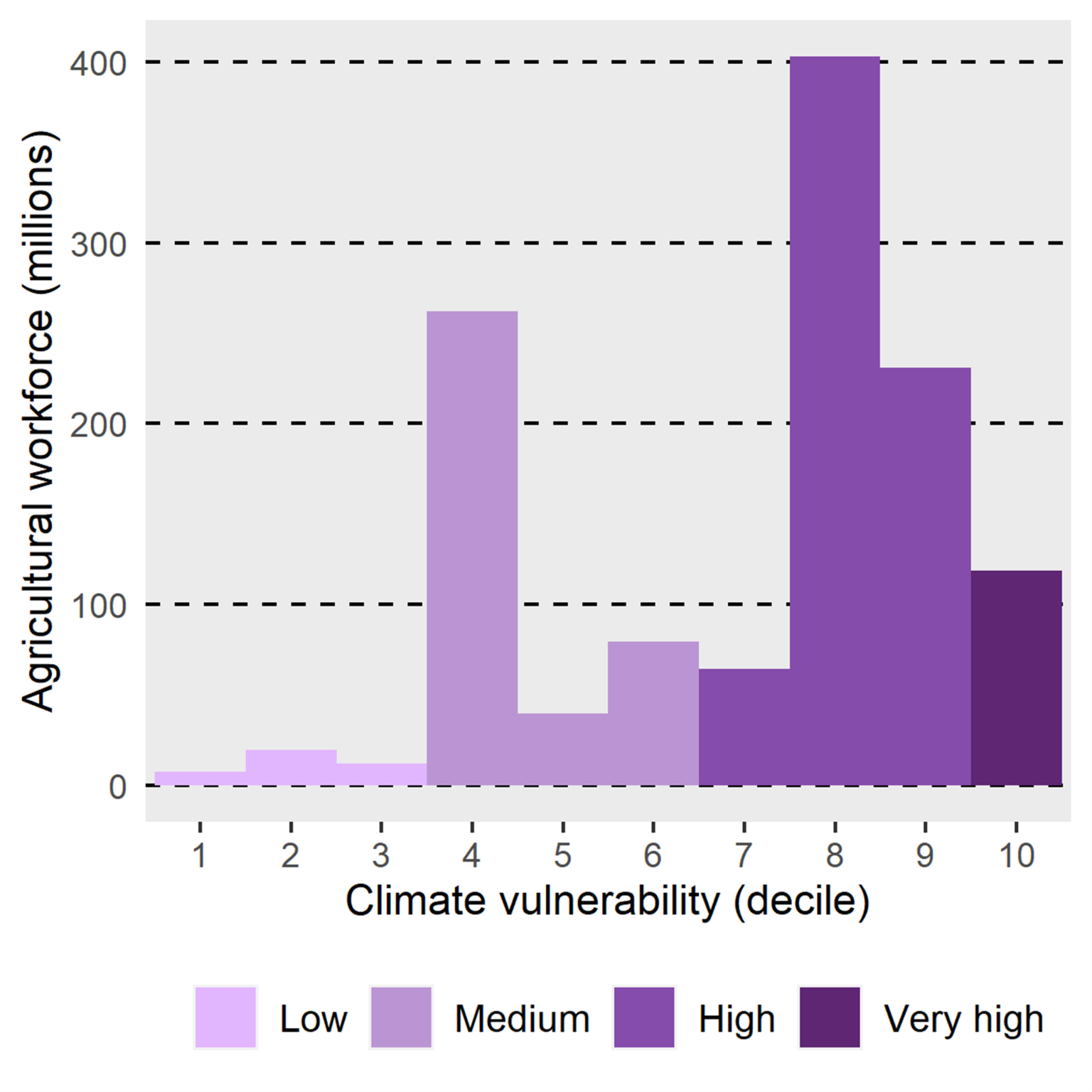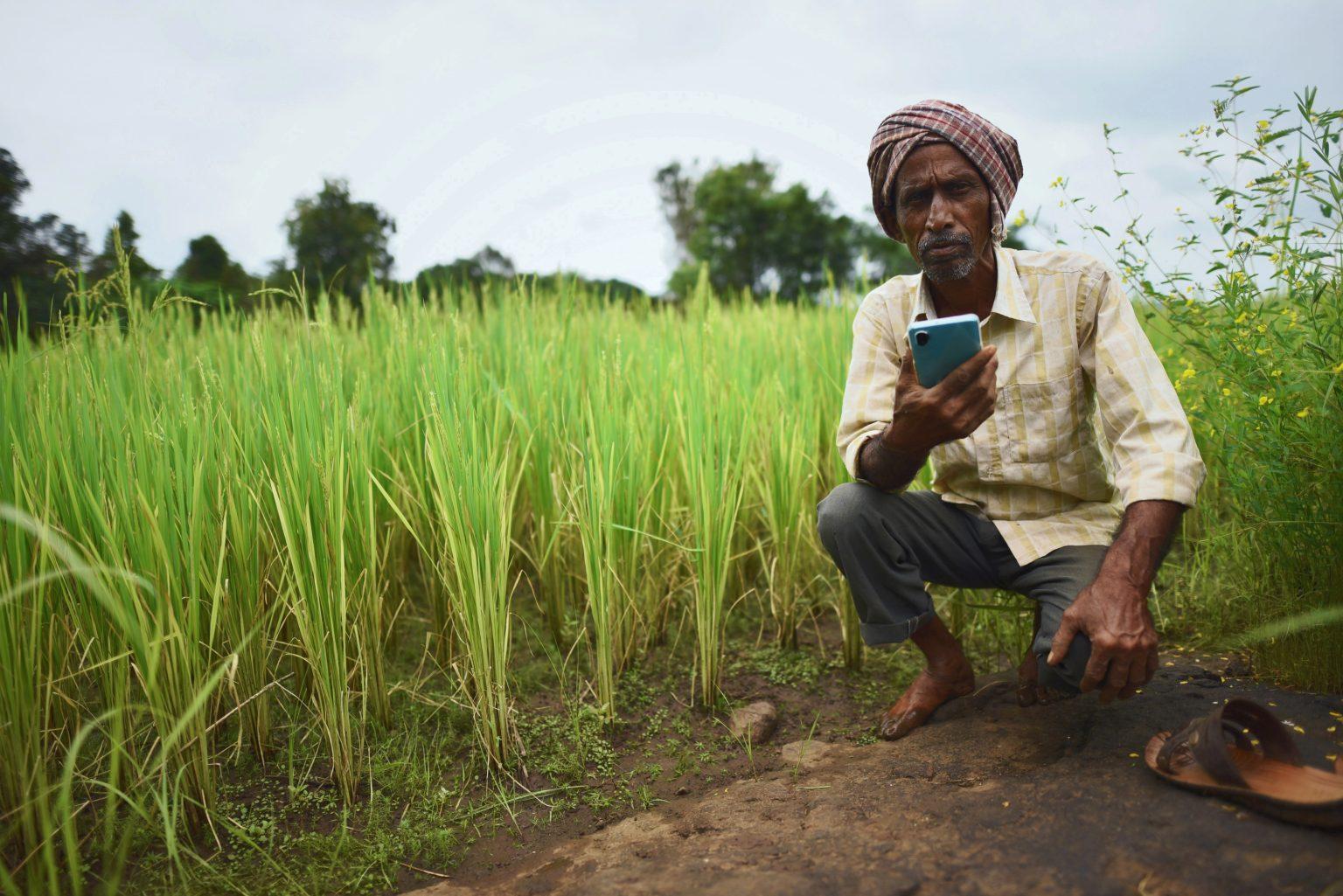
Risk and resilience: Agricultural adaptation to climate change in developing countries
Successful adaptation to climate change will require more accurate weather forecasts that can inform investment and production decisions, alongside financial products that can help farmers manage shocks.
Introduction
Agriculture will be severely affected by climate change. Higher temperatures and increased variability pose an enormous threat to agricultural production. Not only are developing countries disproportionately exposed to climate change, they are also more vulnerable to its impacts owing to higher prevalence of subsistence farming, food insecurity, and extreme poverty.
With major climatic changes now inevitable and irreversible, adaptation is necessary. Undertaking adaptation efficiently and effectively will be difficult as, like the returns to agricultural decisions, it will depend on the weather. Investing in adaptation prior to changes in the weather is risky because weather changes may not occur. On the other hand, waiting until the weather does change may limit the potential actions that can be deployed in response. Greater weather variability will add variability to the costs and benefits of adaptation strategies.
More accurate weather forecasts can help farmers form more accurate expectations about the future, supporting profitable investment decisions. Investments in weather information services could increase the accuracy, accessibility, and usability of weather information for farmers in the developing world.
Even with perfect forecasts, farmers will not be able to fully adjust to increasing weather variability. Farmers will require mechanisms that can help smooth their consumption during shocks. Access to financial products, such as weather-based index insurance, climate-related loan products, or guaranteed credit lines, can help alleviate some of the risk that comes with climate change.
Key messages
-
Climate change will make agriculture less productive.
Higher temperatures and greater weather variability pose a dual threat to agricultural production. In turn, lower or more variable agricultural output will have significant ramifications for food security, poverty, and development.
-
Adapting to higher weather variability will be more challenging than adapting to increases in average temperature.
Like other agricultural outcomes, adaptation’s implications for farmers’ profits will depend on whether expected weather changes actually happen. Ex ante and ex post adaptation actions have different costs and benefits.
-
More accurate weather forecasts can help farmers make more profitable decisions.
Greater access to and accuracy of weather information appears to increase agricultural profitability on average. Weather and climate information services are an increasingly popular policy tool in developing countries.
-
Market mechanisms that lower agricultural risk can lead to greater investment and better management of shocks.
As climate change increases risk, it may lead to adverse impacts on farmer investment. Weather-based insurance and tailored loan products are promising tools to lower risk and support farmers’ incomes and investment.
Key message 1 – Climate change will make agriculture less productive.
The scale and pace of human-induced climate change is unprecedented (IPCC, 2021). Global average temperatures are rising, and extreme events such as heatwaves, cyclones, heavy rain, and droughts are becoming more frequent. These phenomena are widespread, making weather conditions both harsher and more unpredictable across the globe. With each Intergovernmental Panel on Climate Change (IPCC) assessment, the scale of observed and expected climate change increases, with worsening impacts on natural and human systems (UNEP, 2021). Even with aggressive climate policy, climate change will increase over the 21st century. A future with more unpredictable and volatile weather systems is unavoidable, creating significant repercussions for how humans interact with, rely on, and survive in the natural environment.
The agricultural sector is highly vulnerable to the impacts of climate change, particularly in low- and middle-income countries. Since agriculture is acutely dependent on weather and climate, changes in temperatures and precipitation directly affect growing conditions and yields. At a global level, a 1°C rise in temperatures could reduce crop yields by 7.4% for maize, 3.2% for rice, and 6% for wheat (Zhao et al., 2017). In tropical and subtropical regions, the impact from higher temperatures on agricultural revenue is expected to be larger than that in temperate regions (Mendelsohn, 2008). This implies that developing countries are disproportionately exposed. In Africa and Asia, a high-emissions scenario (RCP8.5) could see major crop yields fall dramatically by 2050 (Figure 1).
Figure 1: A high-emissions scenario would be catastrophic for major crop yields in African and Asian countries

Source: Authors’ calculations based on Climate Adaptation in Rural Development Assessment Tool, IFAD (2021)
Higher temperatures and greater weather variability pose a dual threat to agricultural production. Across the globe, deviations of precipitation and temperature from long-run averages have a significant impact on yields and productivity (Mearns et al., 1997, Dixon et al., 2003). These fluctuations, referred to as inter-annual climate variability, are expected to worsen with climate change and add to the already high levels of risk and uncertainty present in agricultural production in developing countries (Sonwa et al., 2017). In semi-arid regions such as the Sahel and the Horn of Africa, heavier seasonal rainfalls can cause flooding and damage to crops, while droughts can lead to famines (WMO, 2021). IGC researchers have also found greater variability in weather leads to greater variability in profitability (Rosenzweig & Udry, 2020).
Figure 2: Most of the world’s agricultural workforce are in countries that are highly vulnerable to climate change

Source: Authors’ calculations based on World Development Indicators (WB, 2021) and ND-Gain Climate Change Risk Index (2021)
Lower or more variable agricultural output will have significant ramifications for food security, poverty, and development. On average, agriculture accounts for two-thirds of the workforce and one-third of GDP across low-income countries (World Bank, 2021). Most of the global agricultural workforce lives in countries at high risk of climate change (Figure 2). The prevalence of subsistence farming, food insecurity, and extreme poverty across the developing world make millions acutely vulnerable to the impacts of climate change. These impacts could lead to internal climate migration of up to 143 million people by 2050, adding significant pressure to infrastructure and social support systems (World Bank, 2018). Climate shocks can trigger conflicts, such as between pastoralists and farmers (Nunn & McGuirk, 2021), which may become more frequent. Gender disparities may also widen, with some evidence suggesting that the costs of climate change fall disproportionately on women-headed households (Wossen, 2018, Eskander & Steele, 2019). Together, these patterns point to exacerbating inequality and vulnerability in already unequal and vulnerable contexts.
Key message 2 – Adapting to higher variability in temperature and precipitation will be more challenging than adapting to increases in average temperature.
Agricultural adaptation will be required in the face of growing climate risk and uncertainty. Adaptation is the process of adjustment to the actual or expected climate and its effects (IPCC, 2014), making agricultural production less sensitive to weather and climate. However, maladaptation can occur, where the process of adaptation leads to new vulnerabilities or harms different segments of the population (UNEP, 2021). Thus, undertaking adaptation efficiently and effectively is difficult.
The process of adaptation will typically incur costs, often in foregone revenue or capital expenditures. But not adapting will be more costly, since successful adaptation will, on average, increase yields. Like other agricultural outcomes, however, the profit implications of adaptation will depend on weather-change realisations. For example, investments into irrigation practices may be unprofitable if precipitation remains high. In such an instance, it would have been more profitable to avoid the irrigation investment and continue to rely on rainfall. Here the farmer was basing the investment decision on information available ex ante while the final profit outcome was determined by precipitation realisations ex post.
Adaptations can be conceptualised as follows (Mendelsohn, 2000, Lemoine, 2018):
- Ex ante adaptation: where actions are based on expectations of future weather, such as farmers investing in flood-resilient seeds
- Ex post adaptation: where actions are based on realisations of weather change, such as farmers watering crops during a heatwave
- Undertaken by private or public actors
- Occur indirectly: when actors are not responding to weather at all, such as a farmer adopting technology to maximise profit, and as a by-product lowering the sensitivity of their yields to climate change
Ex ante adaptation
Ex ante adaptation is undertaken beforehand and on the basis of expected changes in weather and climate. This has the benefit of allowing a greater range of potential adjustments, such as switching crops or changing planting patterns. However, it also carries greater ex post risk, since the degree to which the adjustments pay off depend on weather-change realisations. Thus, as the variability of weather and climate increases, the benefits of ex ante adaptation strategies also become more variable. For example, investing in flood-tolerant rice varieties in India increased yields by around 45% when they were flooded for 10 days, but importantly had no reduction in yields when flooding did not occur (Dar et al., 2013). Since this technology had no negative yield penalty when the weather was good, the variance of possible outcomes was lower. This helps to minimise the cost and risk of investment. Nevertheless, investing in flood-tolerant rice still incurs an upfront adjustment cost (such as the purchase of new or more expensive seeds) and so would lower profits ex post if no flooding occurred, even if expected profits were higher than with regular seeds.
Ex post adaptation
Ex post adaptation, on the other hand, occurs after weather or climate is observed. As a result, a smaller range of adaptation strategies can be deployed ex post, such as increased watering or mulching around plants. These may be less effective than ex ante strategies but will only be deployed when the weather determines that it is profitable to do so. Ex post adaptation might therefore be preferred to ex ante when there is a high degree of weather and outcome variability, when ex ante strategies have high upfront costs, or when ex post strategies offer effective means of addressing weather shocks. Some adaptation actions might rely on scarce resources, which increases their costs and makes them more valuable as an ex post strategy used only once a weather event has arrived (Lemoine, 2018). For example, using groundwater can help alleviate water scarcity in the short-term, but offers an unsustainable long-term solution (Fishman, 2018). Ex post adaptation can help to avoid large losses when the variability of outcomes is large, and actors might default more to it given its smaller risk profile. However, in many cases, ex post solutions will be inadequate to address increasing extreme weather.
Underpinning the efficiency of ex ante or ex post decisions is the importance of information and expectations, and the capacity to alleviate risk and respond to shocks.
Key message 3 – More accurate weather forecasts can help farmers make more profitable decisions.
Both the actual realisation of weather as well as expectations of future weather affect agricultural outcomes (Hsiang, 2016). Expectations inform investment and production decisions ex ante. Surveys of farmers across multiple African countries report perceiving changes in the climate and then implementing adaptation measures in response (Maddison, 2007, Hassan & Nhemachena, 2008). Weather realisations then determine whether those decisions become profitable.
Even in the absence of climate change, investment decisions in agriculture are beset by substantial cost and risk. In one study, IGC researchers find investment returns to be highly sensitive to the realisation of rainfall, which is itself highly variable. Owing to this variability in rainfall, in 95% of instances, the realised profitability from investment deviated more than 30 percentages points of what was expected (Rosenzweig & Udry, 2020). This demonstrates how difficult it is for farmers to estimate the returns to investment in rain-fed agriculture.
Increased weather variability arising from climate change will make it even harder to form accurate expectations and make ex ante investment decisions. In general, higher variability will make it less likely that investment returns are realised. Weather forecasting may also become less accurate, increasing the difficulty of planting and production decisions, particularly in rainfall-dependent areas (Scher & Messori, 2019). Africa has the world’s least developed weather, water, and climate observation network, which often reports inaccurate data and leads to losses for farmers (World Bank, 2017).
Better weather forecasting
More accurate weather forecasts should allow farmers to make better investment decisions. In India, IGC researchers find that farmers respond more strongly to forecasts in villages where those forecasts have tended to be more accurate in the past. In those villages, investment decisions respond to forecasts about the onset of the monsoon. Whilst farmers who relied on forecasts had higher average profit levels, they also experienced greater profit variability. When rainfall realisations were high, they performed better than farmers without access to forecasts. However, the opposite was true when rainfall realisations were low (Rosenzweig & Udry, 2014).
Weather and climate information services (WCS) have become an increasingly popular policy tool in low-income countries. WCS incorporate weather forecasts alongside production, translation, and communication of weather and climate information to aid farmers’ decision-making. Existing research on WCS access, usage, and impact shows disparate impacts (Vaughan et al., 2019). Access can differ between pastoralists and farmers, men and women, and the type of service on offer. Where information is easily accessible, it is mostly used (Vaughan et al., 2019). For farmers, information tends to feed into decisions on field and crop selection, water conservation, and the general timing of farming activities. Typically, farmers were using seasonal climate forecasts, weather forecasts, and 1-10-day forecasts.
Estimates of impact vary. In some studies, yields were found to increase by double-digits, such as 17% for yam yields in Ghana (Anuga & Gordon, 2016) and 64% for sorghum yields in Mauritania (Tarchiani et al., 2018). In Senegal, a study found that farmers’ incomes increased when a particularly dry season was correctly forecasted (Sultan et al., 2010). In other studies, losses were experienced amongst some farmers, or tied very closely to the accuracy of forecasts (Ziervogel et al., 2005, Roudier et al., 2014). These latter findings echo those of Rosenzweig and Udry (2014) where the usage of forecasts led to greater profit variability.
Image 1: More accurate weather forecasts should allow farmers to make better investment decisions

Overall, greater access to and accuracy of weather information appears to increase agricultural profitability on average. However, the considerable variation that exists across contexts and users means that more evidence is needed to inform the appropriate design and cost of interventions. If profits are more variable when more decisions are based on forecasts, it is likely that this variation will only widen with climate change. More income variation will require further mechanisms to help reduce risks and cope with shocks.
Key message 4 – Market mechanisms that lower agricultural risk can lead to greater investment and better management of shocks.
Climate change will inevitably bring unexpected weather outcomes and failed investments. Farmers face more risk and uncertainty, with yields and incomes threatened on a more frequent basis. As discussed, even with more accurate weather forecasts, increased weather variability can cause more variability in profits. This will require farmers to find strategies to smooth the relationship between variable incomes and consumption.
Risk is an important determinant of investment decisions (Karlan et al., 2014). As climate change increases risk, it may lead to adverse impacts on investment. Investment decisions made by farmers who face rainfall variability tend to be more risk-averse, which is even more pronounced for those in the lowest income groups (Rosenzweig & Binswanger, 1992, Dercon & Christiaensen, 2011). It has been linked with underinvestment (Rosenzweig & Udry, 2014) and less adoption of profitable technologies (Dercon & Christiaensen, 2011). Outside of investment, climate risk can influence many aspects of farmer decision-making, such as land and labour contracts, that in turn influence the probability of technological adoption and agricultural productivity (Melesse et al., 2017).
Role of insurance
Insurance markets can be a key tool for alleviating this risk. Weather-based index insurance products have become more prevalent over the past decade. In exchange for a premium, insurance products provide a payment when weather outcomes cross a certain threshold (Magruder, 2018). Research has found positive effects from the adoption of weather-based index insurance. It can lead to significantly larger and riskier investment decisions (Karlan et al., 2014), such as in more high-yielding and rainfall-sensitive crops (Mobarak & Rosenzweig, 2014, Cole et al., 2017). It has been linked with increased production and input expenditure (Elabed & Carter, 2014). IGC researchers have also shown it is related to higher investment and a smoothing of wages if offered to labourers (Mobarak & Rosenzweig, 2014).
Despite the apparent benefit of weather-index insurance, evidence varies on whether there is sufficient market demand for these products (J-PAL et al., 2016). Whilst Karlan et al. (2014) identifies sufficient demand for a viable market, demand for insurance products might be harmed by low levels of trust or a low frequency of pay-outs when weather outcomes are positive. Demand for insurance products might be improved through better product design, including the contract, measurement, and pricing (Carter et al., 2017). At the same time, as the frequency and severity of climate shocks increase, this will affect the capital and financing requirements of insurance providers (McKinsey, 2020).
Role of credit
Credit markets are another important mechanism that influences investment decisions and the capacity of farmers to deal with shocks. Uncertain weather can influence farmers’ decisions to borrow and invest, for fear of not being able to repay. Alternatively, credit providers may not be willing to lend or may increase interest rates in the face of greater yield uncertainty. The provision of insurance can foster greater borrowing and investment through the reduction of risk (Karlan et al., 2011). On the other hand, if insurance is too costly – or eliminates farmers’ ability to default in the case of low yields – it may lead to less borrowing (Brune et al., 2016). In the face of greater weather variability and risk, designing more tailored loan products may incentivise borrowing. Subsidised loans that are synchronised with seasonal flows in income and production can support agricultural output and wages (Fink et al., 2020). A guaranteed credit line for households to access when hit by a shock can have a double dividend by both incentivising riskier investment before the shock arrives, and smoothing consumption after it hits (Lane, 2018). In addition to smoothing through borrowing, increased access to low-cost and secure savings could help farmers adjust to more variable income and climate shocks (Somville & Vandewalle, 2019).
Minimising the risk that comes with climate change and increased weather variability will be an effective way to support incomes and investment. There will be a role for broader economic policy in doing so, such as social protection programmes that help households manage shocks and diversify their economic activities (Macours et al., 2012). Well-designed and affordable financial products, including insurance and credit, can be important catalysts to help farmers take on riskier investment decisions and adopt profitable technologies. These technologies can help farmers adapt to climate change and reduce their risk further. The benefits of climate-resilient technology can go beyond adaptation, and help crowd-in modern inputs and practices, further supporting climate resilience and productivity (Emerick et al., 2016).
Policy recommendations
Agricultural adaptation will be crucial for protecting farmers’ livelihoods and mitigating the impact of climate change on food security and poverty. At the same time, it will help lay the foundations to support the investment and growth that agricultural sectors in developing countries require. This brief has highlighted the role that more accurate and accessible weather information and tailored financial products can have in promoting investment in a world with greater weather variability. Policymakers will need to understand which interventions will work best in their context, given the substantial heterogeneity across agricultural sectors in the developing world.
The evidence presented in this brief highlights four areas for policy action:
- Improve the quality of national weather and climate information. Investing in national weather infrastructure can pay for itself by helping to avoid asset and wellbeing losses, together with gains in productivity (World Bank, 2017). In addition, partnerships between policymakers and researchers in developing countries and global weather forecasters can help rapidly translate complex global models into local weather forecasts (Webster, 2013).
- Evaluate how weather and climate information can be best delivered.Weather and climate services (WCS) offer a promising way to utilise existing IT and communications infrastructure to deliver tailored information to farmers. These services differ considerably with respect to the information they provide and how it is communicated. Similarly, the extent to which farmers use these services varies by location, household, and farm characteristics. As such, it is important to understand what types of services can be most effective in different contexts.
- Design viable insurance products. Weather-index insurance products can be an effective tool to mitigate risk and support investment. Currently, the feasibility of these products is questioned due to demand-constraints and a lack of uptake. These constraints could be alleviated through better product design, pricing, or communication.
- Develop flexible and tailored credit markets. Credit and insurance can complement each other to incentivise borrowing and riskier investment. Both supply- and demand-side constraints prevent farmers from borrowing. To alleviate the impact of greater weather variability, credit products should offer flexibility or a closer alignment with agricultural income. Policymakers should work with financial providers and farmers to understand how these products can be adapted to local needs.
References
Anuga, S. W., and Gordon, C. (2016). “Adoption of climate-smart weather practices among smallholder food crop farmers in the Techiman municipal: Implication for crop yield.” Research Journal of Agriculture and Environmental Management, 5(9), 279-286.
Brune, L., Giné, X., Goldberg, J., & Yang, D. (2016). “Facilitating savings for agriculture: Field experimental evidence from Malawi.” Economic Development and Cultural Change, 64(2), 187-220.
Carter, M., de Janvry, A., Sadoulet, E., and Sarris, A. (2017). “Index insurance for developing country agriculture: a reassessment.” Annual Review of Resource Economics, 9, 421-438.
Cole, S., Giné, X., and Vickery, J. (2017). “How does risk management influence production decisions? Evidence from a field experiment.” The Review of Financial Studies, 30(6), 1935-1970.
Dar, M. H., de Janvry, A., Emerick, K., Raitzer, D., and Sadoulet, E. (2013). “Flood-tolerant rice reduces yield variability and raises expected yield, differentially benefitting socially disadvantaged groups.” Scientific reports, 3(1), 1-8.
Dercon, S., and Christiaensen, L. (2011). “Consumption risk, technology adoption and poverty traps: Evidence from Ethiopia.” Journal of development economics, 96(2), 159-173.
Dixon, R. K., Smith, J., and Guill, S. (2003). “Life on the edge: vulnerability and adaptation of African ecosystems to global climate change.” Mitigation and Adaptation Strategies for Global Change, 8(2), 93-113.
Elabed, G., and Carter, M. (2014). “Ex-ante impacts of agricultural insurance: Evidence from a field experiment in Mali.” University of California at Davis.
Emerick, K., De Janvry, A., Sadoulet, E., and Dar, M. H. (2016). “Technological innovations, downside risk, and the modernization of agriculture.” American Economic Review, 106(6), 1537-61.
Eskander, S. and Steele, P. (2019). “Bearing the climate burden: how households in Bangladesh are spending too much.” IIED, London.
Fink, G., Jack, B. K., and Masiye, F. (2020). “Seasonal liquidity, rural labor markets, and agricultural production.” American Economic Review, 110(11), 3351-92.
Fishman, R. (2018). “Groundwater depletion limits the scope for adaptation to increased rainfall variability in India.” Climatic change, 147(1), 195-209.
Hassan, R. M., and Nhemachena, C. (2008). “Determinants of African farmers’ strategies for adapting to climate change: Multinomial choice analysis.” African Journal of Agricultural and Resource Economics, 2(311-2016-5521), 83-104.
Hsiang, S. (2016). “Climate econometrics.” Annual Review of Resource Economics, 8, 43-75.
IPCC, 2014: “Summary for policymakers.” In: Climate Change 2014: Impacts, Adaptation, and Vulnerability. Part A: Global and Sectoral Aspects. Contribution of Working Group II to the Fifth Assessment Report of the Intergovernmental Panel on Climate Change. [Field, C.B., V.R. Barros, D.J. Dokken, K.J. Mach, M.D. Mastrandrea, T.E. Bilir, M. Chatterjee, K.L. Ebi, Y.O. Estrada, R.C. Genova, B. Girma, E.S. Kissel, A.N. Levy, S. MacCracken, P.R. Mastrandrea, and L.L.White (eds.)]. Cambridge University Press, Cambridge, United Kingdom and New York, NY, USA, pp. 1-32.
IPCC, 2021: “Climate Change 2021: The Physical Science Basis. Contribution of Working Group I to the Sixth Assessment Report of the Intergovernmental Panel on Climate Change.” [Masson-Delmotte, V., P. Zhai, A. Pirani, S.L. Connors, C. Péan, S. Berger, N. Caud, Y. Chen, L. Goldfarb, M.I. Gomis, M. Huang, K. Leitzell, E. Lonnoy, J.B.R. Matthews, T.K. Maycock, T. Waterfield, O. Yelekçi, R. Yu, and B. Zhou (eds.)]. Cambridge University Press. In Press.
J-PAL, CEGA, and ATAI Policy Bulletin. 2016. “Make it Rain.” Cambridge, MA: Abdul Latif Jameel Poverty Action Lab, Center for Effective Global Action, and Agricultural Technology Adoption Initiative.
Karlan, D., Kutsoati, E., McMillan, M., and Udry, C. (2011). “Crop price indemnified loans for farmers: A pilot experiment in rural Ghana.” Journal of Risk and Insurance, 78(1), 37-55.
Karlan, D., Osei, R., Osei-Akoto, I., and Udry, C. (2014). “Agricultural decisions after relaxing credit and risk constraints.” The Quarterly Journal of Economics, 129(2), 597-652.
Lane, G. (2018). “Credit lines as insurance: Evidence from Bangladesh.” Job Market Paper.
Lemoine, D. (2018). “Estimating the consequences of climate change from variation in weather (No. w25008).” National Bureau of Economic Research.
Maddison, D. (2007). The perception of and adaptation to climate change in Africa (Vol. 4308). World Bank Publications.
Magruder, J. R. (2018). “An assessment of experimental evidence on agricultural technology adoption in developing countries.” Annual Review of Resource Economics, 10, 299-316.
McKinsey (2020). “Climate change and PandC insurance: The threat and opportunity.” Available: https://www.mckinsey.com/industries/financial-services/our-insights/climate-change-and-p-and-c-insurance-the-threat-and-opportunity
Mearns, L. O., Rosenzweig, C., and Goldberg, R. (1997). “Mean and variance change in climate scenarios: methods, agricultural applications, and measures of uncertainty.” Climatic Change, 35(4), 367-396.
Melesse, K., Sore, A., Fuje, H. (2017). “Weather Risk, Contracts, and Technology Adoption: Evidence from Ethiopia.” International Growth Centre Policy Brief, F-32204-ETH-1.
Mendelsohn, R. (2000). “Efficient adaptation to climate change.” Climatic Change, 45(3), 583-600.
Mendelsohn, R. (2008). “The impact of climate change on agriculture in developing countries.” Journal of Natural Resources Policy Research, 1(1), 5-19.
Mobarak, A. M., and Rosenzweig, M. (2014). Risk, insurance and wages in general equilibrium (No. w19811). National Bureau of Economic Research.
Nunn, N., McGuirk, E. (2021). “How climate shocks trigger inter-group conflicts: Evidence from Africa’s transhumant pastoralists.” Available: https://voxdev.org/topic/energy-environment/how-climate-shocks-trigger-inter-group-conflicts-evidence-africa-s-seasonal-migrants
Rosenzweig, M. R., and Binswanger, H. P. (1992). Wealth, weather risk, and the composition and profitability of agricultural investments (Vol. 1055). World Bank Publications.
Rosenzweig, M. R., and Udry, C. (2014). “Rainfall forecasts, weather, and wages over the agricultural production cycle.” American Economic Review, 104(5), 278-83.
Rosenzweig, M. R., and Udry, C. (2020). “External validity in a stochastic world: Evidence from low-income countries.” The Review of Economic Studies, 87(1), 343-381.
Roudier, P., Muller, B., d’Aquino, P., Roncoli, C., Soumaré, M. A., Batté, L., and Sultan, B. (2014). “The role of climate forecasts in smallholder agriculture: Lessons from participatory research in two communities in Senegal.” Climate Risk Management, 2, 42-55.
Scher, S., and Messori, G. (2019). “How global warming changes the difficulty of synoptic weather forecasting.” Geophysical Research Letters, 46(5), 2931-2939.
Somville, V., & Vandewalle, L. (2019). “Access to banking, savings and consumption smoothing in rural India (No. 09-2019).” Graduate Institute of International and Development Studies Working Paper.
Sonwa, D. J., Dieye, A., El Mzouri, E. H., Majule, A., Mugabe, F. T., Omolo, N., … and Brooks, N. (2017). “Drivers of climate risk in African agriculture.” Climate and Development, 9(5), 383-398.
Sultan, B., Barbier, B., Fortilus, J., Mbaye, S. M., and Leclerc, G. (2010). “Estimating the potential economic value of seasonal forecasts in West Africa: A long-term ex-ante assessment in Senegal.” Weather, Climate, and Society, 2(1), 69-87.
Tarchiani, V., Camacho, J., Coulibaly, H., Rossi, F., and Stefanski, R. (2018). “Agrometeorological services for smallholder farmers in West Africa.” Advances in Science and Research, 15, 15-20.
United Nations Environment Programme (2021). “Adaptation Gap Report 2021: The gathering storm – Adapting to climate change in a post-pandemic world.” Nairobi.
Vaughan, C., Hansen, J., Roudier, P., Watkiss, P., and Carr, E. (2019). “Evaluating agricultural weather and climate services in Africa: Evidence, methods, and a learning agenda.” Wiley Interdisciplinary Reviews: Climate Change, 10(4), e586.
Webster, P. (2013). “Improve weather forecasts for the developing world.” Nature, 493, 17–19
World Bank (2017). “Improving Weather Forecasts Can Reduce Losses To Development in Africa.” Available: https://www.worldbank.org/en/news/feature/2017/09/12/improving-weather-forecasts-can-reduce-losses-to-development-in-africa
World Bank (2018). “Groundswell: Preparing for Internal Climate Migration.” Washington DC
World Bank (2021). “World Development Indicators.”
World Meteorological Organisation (2021). “State of the Climate in Africa 2020.” Available: https://library.wmo.int/doc_num.php?explnum_id=10914
Wossen, T. (2018). “Gender-differentiated impacts of climate variability in Ethiopia: A micro-simulation approach.” In Agricultural Adaptation to Climate Change in Africa (pp. 340-359). Routledge.
Zhao, C., Liu, B., Piao, S., Wang, X., Lobell, D. B., Huang, Y., … and Asseng, S. (2017). “Temperature increase reduces global yields of major crops in four independent estimates.” Proceedings of the National Academy of Sciences, 114(35), 9326-9331.
Ziervogel, G., Bithell, M., Washington, R., and Downing, T. (2005). “Agent-based social simulation: a method for assessing the impact of seasonal climate forecast applications among smallholder farmers.” Agricultural systems, 83(1), 1-26.
CITATION
Jack, K. and N.Wilkinson (2022), Risk and resilience: Agricultural adaptation to climate change in developing countries. IGC Growth Brief Series 024. London: International Growth Centre.



